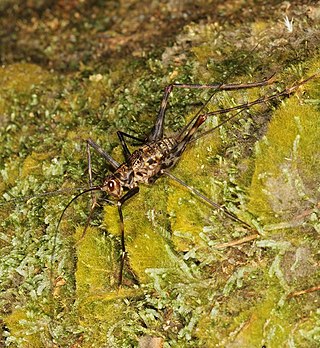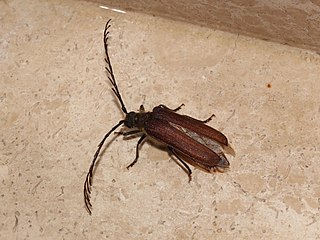
Ensifera is a suborder of insects that includes the various types of crickets and their allies including: true crickets, camel crickets, bush crickets or katydids, grigs, weta and Cooloola monsters. This and the suborder Caelifera make up the order Orthoptera. Ensifera is believed to be a more ancient group than Caelifera, with its origins in the Carboniferous period, the split having occurred at the end of the Permian period. Unlike the Caelifera, the Ensifera contain numerous members that are partially carnivorous, feeding on other insects, as well as plants.

The Kinabalu giant red leech is a large bright orange-red coloured leech that is endemic to Mount Kinabalu, Borneo. It can grow to a length of over 50 cm (20 in).

Isaac Lea was an American publisher, conchologist and geologist. He was a partner in the publishing businesses Matthew Carey & Sons; Carey, Lea & Carey; Carey, Lea & Blanchard; and Lea & Blanchard.

Acronicta is a genus of noctuid moths containing about 150 species distributed mainly in the temperate Holarctic, with some in adjacent subtropical regions. The genus was erected by Carl Linnaeus in his 1758 10th edition of Systema Naturae. Caterpillars of most Acronicta species are unmistakable, with brightly colored hairy spikes, and often feed quite visibly on common foliate trees. The hairy spikes may contain poison, which cause itchy, painful, swollen rash in humans on contact. The larva of the smeared dagger moth is unusually hairy even for this genus. Acronicta species are generally known as dagger moths, as most have one or more black dagger-shaped markings on their forewing uppersides. But some species have a conspicuous dark ring marking instead.

Curculio is a genus of weevils belonging the family Curculionidae and subfamily Curculioninae. Members of the genus are commonly referred to as acorn weevils or nut weevils as they infest the seeds of trees such as oaks and hickories. The adult female weevil bores a tiny hole in the immature nut to lay her eggs, which then hatch into legless grubs. In autumn, the grubs bore holes through the shells from the inside to emerge into the soil where they may live for a year or two before maturing into adults.

Lamiinae, commonly called flat-faced longhorns, are a subfamily of the longhorn beetle family (Cerambycidae). The subfamily includes over 750 genera, rivaled in diversity within the family only by the subfamily Cerambycinae.

Petrophila is a genus of moths of the family Crambidae. The genus was described by Lansdown Guilding in 1830.
Patelloa is a genus of flies in the family Tachinidae.

Phalangopsinae, occasionally known as spider crickets, are a subfamily of crickets in the family Phalangopsidae. Members of Phalangopsinae are found worldwide in tropical and subtropical regions. Most species in the subfamily are nocturnal and can be found in rocky areas, near fallen wood, and the understory of forests. Some species are gregarious, gathering in large numbers.

The Chrysauginae are a subfamily of snout moths. They are primarily Neotropical and include about 400 described species.
Cyrilia is a genus of parasitic alveolates in the phylum Apicomplexa. The genus was created by Lainson in 1981. Species in this genus infect fresh water fish and are transmitted by leeches.

Microplophorus is a genus of beetles in the family Cerambycidae, containing the following species:

Erpobdellidae is a family of leeches. It is one of the four families belonging to the suborder Erpobdelliformes of the proboscisless leeches order, Arhynchobdellida.

The Erpobdelliformes are one of the currently-accepted suborders of the proboscisless leeches (Arhynchobdellida). It includes five families:

Aulonothroscus is a genus of small false click beetles in the family Throscidae. There are more than 20 described species in Aulonothroscus.

Glyptoscelis is a genus of leaf beetles in the subfamily Eumolpinae. There are 38 species of Glyptoscelis described from North, Central and South America. There are also three species of Glyptoscelis known from the West Indies, though they are wrongly placed in the genus. In addition, a single species was described from Hunan, China in 2021.

Melalgus is a genus of horned powder-post beetles in the family Bostrichidae. There are more than 20 described species in Melalgus.

Tomaspis is a genus of true bug from the Cercopidae family. The species was first described scientifically by Amyot & Serville in 1843.

Barbronia is a genus of annelids belonging to the family Salifidae.

Metaleptea is a genus of short-horned grasshoppers in the family Acrididae. There are at least two described species in Metaleptea, found in North, Central, and South America.
















